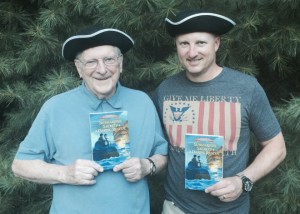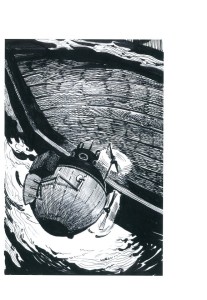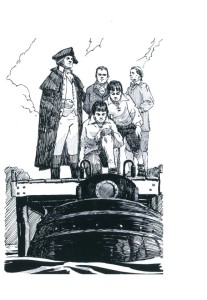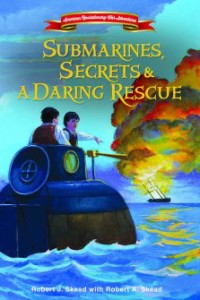 Relevant History welcomes back the father-son team Robert J. Skead, with Robert A. Skead, authors of YA historical fiction. Their ancestor Lamberton Clark fought in the Revolutionary War as a member of the Connecticut Militia and the Continental Army, and their popular children’s books include the American Revolutionary War Adventure series: Patriots, Recoats & Spies and Submarines, Secrets, and a Daring Rescue (Zondervan). To learn more about their books, visit their web site and follow them on Facebook and Twitter.
Relevant History welcomes back the father-son team Robert J. Skead, with Robert A. Skead, authors of YA historical fiction. Their ancestor Lamberton Clark fought in the Revolutionary War as a member of the Connecticut Militia and the Continental Army, and their popular children’s books include the American Revolutionary War Adventure series: Patriots, Recoats & Spies and Submarines, Secrets, and a Daring Rescue (Zondervan). To learn more about their books, visit their web site and follow them on Facebook and Twitter.
*****
I never knew the first submarine invented for warfare was created during the American Revolution. It wasn’t in any of my history books when I was a child. Had I known about it, my interest in the subject, which was already high (I was in sixth grade in 1976 during the Bicentennial), would have peaked even higher.
I stumbled on the American Turtle submarine while searching for possible hooks for the second book in our American Revolutionary War Adventure series crafted with my father. Our goal with the books is to inspire kids and adults to do great things and educate our readers about some “little known” facts or events during this important period in our nation’s history. The first book in our series—Patriots, Redcoats & Spies—used the Culper Spy Ring as a hook. When I saw the image of the American Turtle on my computer screen, my eyes widened, and I had that “Aha!” moment. When I tell kids about it during my author visits, they too are fascinated. How can you not be—a submarine during the American Revolution! Who knew?!
 My PowerPoint presentation used for my author visits shows an image of the Turtle. One child said it looked like a giant acorn, which is true, but the American Acorn doesn’t sound so cool. Others described it as two giant clam shells stuck together, but the American Clam doesn’t work either. When the sub is in the water it looks like a turtle, hence the American Turtle, maybe not a very threatening name, except when you think of its inventor, David Bushnell, saying that his Turtle snaps on command.
My PowerPoint presentation used for my author visits shows an image of the Turtle. One child said it looked like a giant acorn, which is true, but the American Acorn doesn’t sound so cool. Others described it as two giant clam shells stuck together, but the American Clam doesn’t work either. When the sub is in the water it looks like a turtle, hence the American Turtle, maybe not a very threatening name, except when you think of its inventor, David Bushnell, saying that his Turtle snaps on command.
The turtle that more than snaps
The American Turtle was invented to secretly submerge under a British warship and attach a bomb to its hull, and then escape while the fuse burned and the clocked ticked down until BOOM! David Bushnell, a Yale graduate, started inventing the Turtle in 1775 because he first invented underwater explosives (waterproof gunpowder), and he needed a way to deliver it to blow up a ship. Previously when men of war wanted to destroy a ship, they used fire bombs made with oil or other flammable materials, all delivered above the water level. The Governor of Connecticut, the state in which Bushnell lived, who was a Patriot and knew of the invention, recommended it to General George Washington, who, even though he was a little skeptical, invested funds for its continued creation.
The Turtle could hold one man as pilot and operated via pumps and hand-cranked propellers. Tar inside the grooves of the wooden structure made it waterproof. It could submerge for about 20-30 minutes. Glass built into its structure provided some light, but once submerged there would be darkness. That problem was solved, to my surprise, by fungus that would glow in the dark, and that was placed around instrumentation like gauges. Yes, the ingenuity of David Bushnell is so impressive! The fungus would not work in cold weather, so the Turtle didn’t operate in winter.
The Turtle was used several times in New York Harbor but failed to achieve the purpose for which it was created. Patriot Ezra Lee piloted its first mission. The target: The HMS Eagle, Howe’s flagship, stationed off Manhattan.
Lee’s personal account (found in the back of Submarines, Secrets and a Daring Rescue) details how he couldn’t get the bomb to attach to the hull because he hit metal. He tried to connect with another part of the hull, but was not able to stay underneath (imagine all the currents). He had to give up. He reported that the British did spot him and rowed out to investigate. He then released a charge (a floating bomb), which they saw and avoided in retreat. When it exploded, it did so “with tremendous violence, throwing large columns of water and pieces of wood that composed it high into the air.”
The Turtle was exhausting to operate, as you might imagine. Lee tried again a month later, but he was spotted, so he abandoned the mission. The British sunk it later as it sat on its holding device in Fort Lee.
Not so secret, after all
Despite the Continental Army’s best attempts to keep the Turtle’s existence a secret, the British did learn about it, and they didn’t take its threat too seriously. It seems a Loyalist tavern keeper and postmaster had intercepted Bushnell’s mail and learned of it, and a coded message was then sent to British attention. The message contained some inaccuracies, stating it was ready to be used when in fact it was still being developed in the Connecticut River.
Washington says!
George Washington wrote to Thomas Jefferson that the Turtle was an “effort of genius.” He described David Bushnell as “a man of great mechanical powers—fertile in invention and a master in execution.”
Our adventure
 In Submarines, Secrets and a Daring Rescue, fifteen-year-old twins, Ambrose and John Clark, once again find themselves in the thick of things in service of the newly forming United States of America. Their new mission: help transport much-needed gunpowder to the patriots. When they end up in an even more dangerous situation—manning one of the first submarines—it seems the worst is behind them. Until they have to attempt a prison break to rescue one of their older brothers. Follow these brave young patriots as they continue to follow in their father’s footsteps and take even bigger leaps of faith.
In Submarines, Secrets and a Daring Rescue, fifteen-year-old twins, Ambrose and John Clark, once again find themselves in the thick of things in service of the newly forming United States of America. Their new mission: help transport much-needed gunpowder to the patriots. When they end up in an even more dangerous situation—manning one of the first submarines—it seems the worst is behind them. Until they have to attempt a prison break to rescue one of their older brothers. Follow these brave young patriots as they continue to follow in their father’s footsteps and take even bigger leaps of faith.
*****
 A big thanks to Robert Skead. He’ll give away autographed paperback copies of Submarines, Secrets, and a Daring Rescue to two people who contribute a comment on my blog this week. I’ll choose the winner from among those who comment by Friday at 6 p.m. ET. Delivery is available is the U.S. only.
A big thanks to Robert Skead. He’ll give away autographed paperback copies of Submarines, Secrets, and a Daring Rescue to two people who contribute a comment on my blog this week. I’ll choose the winner from among those who comment by Friday at 6 p.m. ET. Delivery is available is the U.S. only.
**********
Did you like what you read? Learn about downloads, discounts, and special offers from Relevant History authors and Suzanne Adair. Subscribe to Suzanne’s free newsletter.
